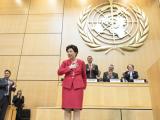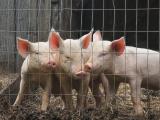Jan 29, 2010
H1N1 still active in some global regions
Although pandemic flu has declined in most of the Northern Hemisphere, transmission remains active in some regions of North Africa, eastern and southeastern Europe, and South and East Asia, the World Health Organization (WHO) reported today. Global H1N1 deaths now total at least 14,711. Novel H1N1 remains dominant in most nations, according to a separate WHO update, but in China 49% of flu isolates are the seasonal B strain. Other countries are detecting some seasonal flu, too.
http://www.who.int/csr/don/2010_01_29/en/index.html
Jan 29 WHO weekly update
US flu activity stayed low last week
H1N1 flu activity stayed at about the same low level last week as the week before, the Centers for Disease Control and Prevention (CDC) said today. No states had widespread cases; five had regional activity. Five flu-related deaths in children were reported. The share of medical visits ascribed to flu-like illness was 1.7%, below the national baseline of 2.3%, but the fraction of deaths due to flu and pneumonia remained above the epidemic threshold. All but two tested viruses were novel H1N1.
http://www.cdc.gov/flu/weekly/?date=012910
Jan 29 CDC weekly flu update
Flu down, vaccine availability up at colleges
Flu activity at US colleges declined again after leveling off the previous week, the American College Health Association (ACHA) reported. The attack rate was 2.3 per 10,000 students. Though the number of vaccinated students was around 9%, the ACHA reports some encouraging signs. Some institutions are reporting vaccine uptake rates exceeding 25% to 30%. Vaccine availability has improved, with 86% of campuses reporting that they have it.
http://www.acha.org/ILI_Project/ILI_Surveillance.cfm/?date=012910
ACHA report for week ending Jan 22
Vaccine from 1918, 1976 strains may fend off novel H1N1
In an experiment to learn more about pre-existing immunity, researchers found that mice vaccinated with 1918-like and classical (from 1976) swine flu vaccines had complete protection against pandemic H1N1, according to a study in PLoS Pathogens. In contrast, vaccines based on more recent seasonal H1N1 strains afforded only partial protection. The authors say their findings underscore the importance of having people under age 35 receive the pandemic vaccine.
http://www.plospathogens.org/article/info%3Adoi%2F10.1371%2Fjournal.ppat.1000745
Jan 29 PLoS Pathog article
China denies vaccine-miscarriage link
China's government denied a link between H1N1 vaccine and miscarriages after an official said "several" miscarriages occurred among 10,000 pregnant women who had been immunized, Agence France-Presse (AFP) reported today. The official added the miscarriages were coincidental and that most were seen in women in their first trimester. He emphasized that global experience so far shows the vaccine is safe and effective in pregnant women, who are at high risk for flu complications.
http://www.mysinchew.com/node/34657
Jan 29 AFP story


















